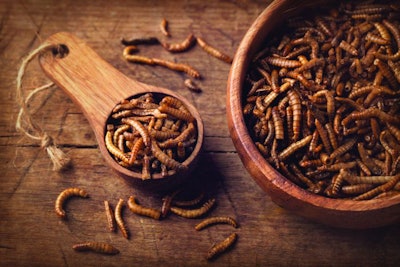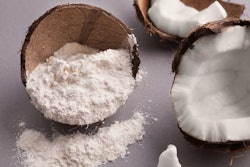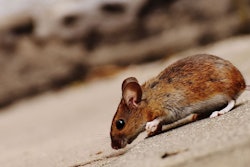
The insect pet food market is growing, both in terms of global market share and acceptability among pet owners. According to Future Market Insights (FMI)’s November 2021 report, “Insect-based Pet Food Market by Nature, Source, Product Type, Pet Type, Distribution Channel & Region – Forecast to 2021–2031,” the market held an estimated 7% of the US$104.96 billion global pet food market in 2021. The estimated market value, US$7.09 billion in 2021, is projected to hit US$17.29 billion by 2031, according to FMI, a compound annual growth rate (CAGR) of 9.3% for 2021–2031.
“Novel protein sources are critical to meet growing consumer expectations of sustainability, nutrition, natural products and supply chain transparency,” said Aimee Rudolph, vice president of business development at insect entrepreneur Beta Hatch. According to her Petfood Forum 2021 presentation, “Mealworms as a sustainable alternative protein for pet food and treats,” increased pressure on the global food system is a significant reason for the growing interest in insects as protein sources.
“The current food system cannot scale to this level of production the same way it has in the past,” Rudolph said with regards to increased human and pet populations and their needs.
Recent research on insects in pet food
There are several insects at the top of the list when it comes to their use in pet food. Black soldier fly larvae [which received Association of American Feed Control Officials (AAFCO)’s tentative approval for use in adult dog food in mid-2021] have been on the docket nearly since the beginning. Mealworms, which are incredibly rich in protein (56g of protein per 100g serving, according to Beta Hatch data), are another top option. Crickets — already a common food for other types of pets such as reptiles as well as humans in some parts of the world — are also part of the conversation, as are silkworms.
A study published in September 2021 in the journal “Animals” looked at the possibility of using house crickets or mulberry silkworms to replace poultry meal in dog diets, and found that crickets or mulberry silkworms could adequately substitute for poultry meal (at levels of up to 20% and 14%, respectively) in canine diets without adverse effects on hematology, blood chemistry, body weight, body condition score, feed intake, fecal output, fecal score, fecal moisture or apparent tract digestibility. The conclusions (“Possibility of Using House Cricket or Mulberry Silkworm Pupae Meal to Replace Poultry Meal in Canine Diets Based on Health and Nutrient Digestibility,” Areerat et al., 2021) also suggested that further studies could assess the long-term effects of the ingestion of insect-based diets, particularly with regard to hypersensitivity disorders.
In September 2021 in Taiwan, the Council of Agriculture’s Miaoli District Agricultural Research and Extension Station released the results of their research on a technique for turning silkworm pupae into canned cat food. The results, according to the research, are a food that helps prevent the growth of harmful intestinal bacteria and eliminates the smell of cat feces. In a survey the Extension Station conducted, 70% of cat owner respondents said they’d consider feeding their pet the silkworm pupae.
Growing attention, acceptance of insects as pet food ingredients
According to an FMI survey, “A large number of customers accept insects as a protein source in animal feed. They also expressed an interest in learning more about insects as a sustainable protein source. Growing media attention, as well as campaigns by farmers, academics, professional groups and pet food producers, are helping to raise acceptance of insect-based products among pet experts and owners. Although additional research is needed, there is already significant proof of the benefits of incorporating insects in pet food, which presents manufacturers with plenty of opportunities in the future.”
In November 2021, French insect protein producer Agronutris unveiled plans to invest about €100 million (US$116 million) to launch two new factories in northeastern France that will supply a large share of their output to the European pet food industry. Bühler Group has been chosen as the process solution provider for one of the plants, which is slated to go into operation in 2023.
The 16,000-square-meter insect plant in Rethel, France, when operating at full capacity, will process up to 70,000 tons of organic residues and produce protein for the aquaculture and pet food markets every year, said Bühler in a press release.
“The new project with Agronutris is a milestone for us,” said Andreas Baumann, head of market segment insect technology at Bühler, in the release. “It confirms our goal of establishing ourselves as a key solution provider for the insect industry and to increase the inclusion of insect proteins in animal feed. Our solutions contribute to more sustainable feed supply chains.”
Ÿnsect, which produces natural insect protein and fertilizer, entered the food market in January 2021 and has already seen enough growth to have a US$130 million contract portfolio and to make three new executive hires to kick off 2022.
“2021 has been a great year, and we have moved forward faster than expected, especially with the acquisition of Protifarm in the Netherlands,” said Antoine Hubert, president and CEO of Ÿnsect, in a November 2021 press release. “Today Ÿnsect has three sites, including two in production, and has expectations to hire 500 new employees by 2023. With strong growth on the horizon, it was essential to strengthen our organization to better cope with our acceleration and growth.”
With insect protein-based companies expanding with confidence and acceptance among pet owners growing, insects continue to be a source of interest and possibility as alternative protein sources for pet food, at a time when innovation and diversification are both key buzzwords in the industry.
New pet food product trends winter 2021: insects, health


















